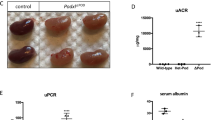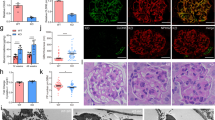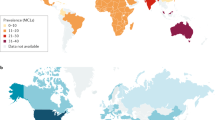Abstract
Disturbances in many different molecular pathways and interactions can lead to the same clinical end points of proteinuria and end-stage renal disease. Proteinuria is often accompanied by a cytopathological change in the glomerulus that is referred to as effacement (retraction) of the podocyte foot processes. The molecular mechanisms that lead to proteinuria and podocyte effacement are poorly understood; therefore, targeted therapies are lacking. During the past 5 years, however, a large body of data has emerged in this field. The discovery of podocyte gene defects that underlie some hereditary proteinuric syndromes has changed our understanding of the relative contributions of components of the glomerular filter. Furthermore, pathogenic pathways activated in podocytes during proteinuria have been identified. Together, these findings pinpoint the podocyte as the most obvious candidate for therapeutic intervention. In the near future, the use of large-scale expression profiling platforms, transgenic mouse lines, and other in vivo gene delivery methods will further expand our understanding of the pathology of the glomerular filtration barrier, and perhaps reveal novel target molecules for the therapy of proteinuric kidney diseases.
Key Points
-
Although the glomerular endothelium, glomerular basement membrane and podocytes all contribute to the filtration barrier, the podocytes seem to be the most critical part of the filtration unit
-
Most cases of proteinuria are associated with retraction (effacement) of podocyte foot processes, although the mechanisms of this association are not well understood
-
Several pathogenic pathways activated in podocytes during the development of proteinuria have been discovered
-
The use of molecular profiling, transgenic mice and in vivo gene delivery will expand our understanding of the glomerular filtration barrier, and perhaps reveal novel therapeutic targets for proteinuria
This is a preview of subscription content, access via your institution
Access options
Subscribe to this journal
Receive 12 print issues and online access
$209.00 per year
only $17.42 per issue
Buy this article
- Purchase on Springer Link
- Instant access to full article PDF
Prices may be subject to local taxes which are calculated during checkout


Similar content being viewed by others
References
Kanwar, Y. S., Linker, A. & Farquhar, M. G. Increased permeability of the glomerular basement membrane to ferritin after removal of glycosaminoglycans (heparan sulfate) by enzyme digestion. J. Cell Biol. 86, 688–693 (1980).
Rossi, M. et al. Heparan sulfate chains of perlecan are indispensable in the lens capsule but not in the kidney. EMBO J. 22, 236–245 (2003).
Harvey, S. J. et al. Disruption of glomerular basement membrane charge through podocyte-specific mutation of agrin does not alter glomerular permselectivity. Am. J. Pathol. 171, 139–152 (2007).
Goldberg, S., Harvey, S. J., Cunningham, J., Tryggvason, K. & Miner, J. H. Glomerular filtration is normal in the absence of both agrin and perlecan-heparan sulfate from the glomerular basement membrane. Nephrol. Dial. Transplant. doi:10.1093/ndt/gfn758.
Tryggvason, K., Patrakka, J. & Wartiovaara, J. Hereditary proteinuria syndromes and mechanisms of proteinuria. N. Engl. J. Med. 354, 1387–1401 (2006).
Haraldsson, B., Nystrom, J. & Deen, W. M. Properties of the glomerular barrier and mechanisms of proteinuria. Physiol. Rev. 88, 451–487 (2008).
Jeansson, M., Bjorck, K., Tenstad, O. & Haraldsson, B. Adriamycin alters glomerular endothelium to induce proteinuria. J. Am. Soc. Nephrol. 20, 114–122 (2009).
Jeansson, M. & Haraldsson, B. Morphological and functional evidence for an important role of the endothelial cell glycocalyx in the glomerular barrier. Am. J. Physiol. Renal Physiol. 290, F111–F116 (2006).
Eremina, V. et al. VEGF inhibition and renal thrombotic microangiopathy. N. Engl. J. Med. 358, 1129–1136 (2008).
Eremina, V. et al. Glomerular-specific alterations of VEGF-A expression lead to distinct congenital and acquired renal diseases. J. Clin. Invest. 111, 707–716 (2003).
Hudson, B. G., Tryggvason, K., Sundaramoorthy, M. & Neilson, E. G. Alport's syndrome, Goodpasture's syndrome, and type IV collagen. N. Engl. J. Med. 348, 2543–2556 (2003).
Utriainen, A. et al. Structurally altered basement membranes and hydrocephalus in a type XVIII collagen deficient mouse line. Hum. Mol. Genet. 13, 2089–2099 (2004).
Miner, J. H. Building the glomerulus: a matricentric view. J. Am. Soc. Nephrol. 16, 857–861 (2005).
Noakes, P. G. et al. The renal glomerulus of mice lacking s-laminin/laminin β2: nephrosis despite molecular compensation by laminin β1. Nat. Genet. 10, 400–406 (1995).
Zenker, M. et al. Human laminin β2 deficiency causes congenital nephrosis with mesangial sclerosis and distinct eye abnormalities. Hum. Mol. Genet. 13, 2625–2632 (2004).
Jarad, G., Cunningham, J., Shaw, A. S. & Miner, J. H. Proteinuria precedes podocyte abnormalities inLamb2-/- mice, implicating the glomerular basement membrane as an albumin barrier. J. Clin. Invest. 116, 2272–2279 (2006).
Oh, J., Reiser, J. & Mundel, P. Dynamic (re)organization of the podocyte actin cytoskeleton in the nephrotic syndrome. Pediatr. Nephrol. 19, 130–137 (2004).
Kreidberg, J. A. et al. α3β1 integrin has a crucial role in kidney and lung organogenesis. Development 122, 3537–3547 (1996).
Sachs, N. et al. Kidney failure in mice lacking the tetraspanin CD151. J. Cell Biol. 175, 33–39 (2006).
Pozzi, A. et al. β1 integrin expression by podocytes is required to maintain glomerular structural integrity. Dev. Biol. 316, 288–301 (2008).
Kanasaki, K. et al. Integrin β1-mediated matrix assembly and signaling are critical for the normal development and function of the kidney glomerulus. Dev. Biol. 313, 584–593 (2008).
Doi, M. et al. Recombinant human laminin-10 (α5β1γ1). Production, purification, and migration-promoting activity on vascular endothelial cells. J. Biol. Chem. 277, 12741–12748 (2002).
Dai, C. et al. Essential role of integrin-linked kinase in podocyte biology: Bridging the integrin and slit diaphragm signaling. J. Am. Soc. Nephrol. 17, 2164–2175 (2006).
El-Aouni, C. et al. Podocyte-specific deletion of integrin-linked kinase results in severe glomerular basement membrane alterations and progressive glomerulosclerosis. J. Am. Soc. Nephrol. 17, 1334–1344 (2006).
Cohen, C. D. et al. Comparative promoter analysis allows de novo identification of specialized cell junction-associated proteins. Proc. Natl Acad. Sci. USA 103, 5682–5687 (2006).
Radice, G. L. et al. Precocious mammary gland development in P-cadherin-deficient mice. J. Cell Biol. 139, 1025–1032 (1997).
Huber, T. B. et al. Bigenic mouse models of focal segmental glomerulosclerosis involving pairwise interaction of CD2AP, Fyn, and synaptopodin. J. Clin. Invest. 116, 1337–1345 (2006).
Jones, N. et al. Nck adaptor proteins link nephrin to the actin cytoskeleton of kidney podocytes. Nature 440, 818–823 (2006).
Verma, R. et al. Nephrin ectodomain engagement results in Src kinase activation, nephrin phosphorylation, Nck recruitment, and actin polymerization. J. Clin. Invest. 116, 1346–1359 (2006).
He, B. et al. Association of genetic variants at 3q22 with nephropathy in patients with type 1 diabetes mellitus. Am. J. Hum. Genet. 84, 5–13 (2009).
Garg, P., Verma, R., Nihalani, D., Johnstone, D. B. & Holzman, L. B. Neph1 cooperates with nephrin to transduce a signal that induces actin polymerization. Mol. Cell. Biol. 27, 8698–8712 (2007).
Reiser, J. et al. TRPC6 is a glomerular slit diaphragm-associated channel required for normal renal function. Nat. Genet. 37, 739–744 (2005).
Winn, M. P. et al. A mutation in the TRPC6 cation channel causes familial focal segmental glomerulosclerosis. Science 308, 1801–1804 (2005).
Dietrich, A. et al. Increased vascular smooth muscle contractility in TRPC6-/- mice. Mol. Cell. Biol. 25, 6980–6989 (2005).
Moller, C. C. et al. Induction of TRPC6 channel in acquired forms of proteinuric kidney disease. J. Am. Soc. Nephrol. 18, 29–36 (2007).
Hinkes, B. et al. Positional cloning uncovers mutations in PLCE1 responsible for a nephrotic syndrome variant that may be reversible. Nat. Genet. 38, 1397–1405 (2006).
Wang, H. et al. Phospholipase C epsilon modulates β-adrenergic receptor-dependent cardiac contraction and inhibits cardiac hypertrophy. Circ. Res. 97, 1305–1313 (2005).
Kao, W. H. et al. MYH9 is associated with nondiabetic end-stage renal disease in African Americans. Nat. Genet. 40, 1185–1192 (2008).
Kopp, J. B. et al. MYH9 is a major-effect risk gene for focal segmental glomerulosclerosis. Nat. Genet. 40, 1175–1184 (2008).
Conti, M. A., Even-Ram, S., Liu, C., Yamada, K. M. & Adelstein, R. S. Defects in cell adhesion and the visceral endoderm following ablation of nonmuscle myosin heavy chain II-A in mice. J. Biol. Chem. 279, 41263–41266 (2004).
Arrondel, C. et al. Expression of the nonmuscle myosin heavy chain IIA in the human kidney and screening for MYH9 mutations in Epstein and Fechtner syndromes. J. Am. Soc. Nephrol. 13, 65–74 (2002).
Wei, C. et al. Modification of kidney barrier function by the urokinase receptor. Nat. Med. 14, 55–63 (2008).
Niranjan, T. et al. The Notch pathway in podocytes plays a role in the development of glomerular disease. Nat. Med. 14, 290–298 (2008).
He, L. et al. Glomerulus-specific mRNA transcripts and proteins identified through kidney expressed sequence tag database analysis. Kidney Int. 71, 889–900 (2007).
Patrakka, J. et al. Expression and subcellular distribution of novel glomerulus-associated proteins dendrin, ehd3, sh2d4a, plekhh2, and 2310066E14Rik. J. Am. Soc. Nephrol. 18, 689–697 (2007).
Takemoto, M. et al. Large-scale identification of genes implicated in kidney glomerulus development and function. EMBO J. 25, 1160–1174 (2006).
Berthier, C. C. et al. Enhanced expression of Janus kinase-signal tranducer and activator of transcription pathway members in human diabetic nephropathy. Diabetes 58, 469–477 (2009).
Faul, C. et al. The actin cytoskeleton of kidney podocytes is a direct target of the antiproteinuric effect of cyclosporine A. Nat. Med. 14, 931–938 (2008).
Acknowledgements
The authors' research is supported by The Swedish Medical Research Council (J. Patrakka and K. Tryggvason), The Swedish Society of Medicine (J. Patrakka), and the Knut and Alice Wallenberg Foundation (K. Tryggvason).
Author information
Authors and Affiliations
Corresponding author
Ethics declarations
Competing interests
The authors declare no competing financial interests.
Rights and permissions
About this article
Cite this article
Patrakka, J., Tryggvason, K. New insights into the role of podocytes in proteinuria. Nat Rev Nephrol 5, 463–468 (2009). https://doi.org/10.1038/nrneph.2009.108
Published:
Issue Date:
DOI: https://doi.org/10.1038/nrneph.2009.108
This article is cited by
-
The E3 ubiquitin ligase TRIM31 plays a critical role in hypertensive nephropathy by promoting proteasomal degradation of MAP3K7 in the TGF-β1 signaling pathway
Cell Death & Differentiation (2022)
-
Detrimental effects of hypoxia on glomerular podocytes
Journal of Physiology and Biochemistry (2021)
-
Inactivation of mediator complex protein 22 in podocytes results in intracellular vacuole formation, podocyte loss and premature death
Scientific Reports (2020)
-
Fractalkine is Involved in Lipopolysaccharide-Induced Podocyte Injury through the Wnt/β-Catenin Pathway in an Acute Kidney Injury Mouse Model
Inflammation (2019)
-
FYVE domain-containing protein ZFYVE28 regulates EGFR-signaling in podocytes but is not critical for the function of filtration barrier in mice
Scientific Reports (2018)



